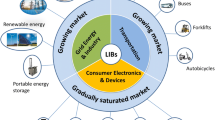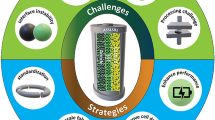Abstract
An impedance measurement approach with various current amplitudes is proposed to investigate the impedance behavior of power Lithium-ion battery in the frequency domain. Notably, the impedance arc is divided into amplitude-independent response in the high-frequency range and amplitude-dependent response in medium-frequency range. A shrinking of semi-circle diameter of the impedance arc at medium-frequency part of measured spectrum is distinctly observed with rising current amplitude. Thus, a series of particular experiments are performed to facilitate the interpretation of the phenomenon. The possible influencing factors for the battery, including its state of charge, internal pressure, and temperature rise during the high-rate short-time charge/discharge, are illustrated and excluded for analysis, respectively. Based on the analysis of Butler-Volmer equation and Arrhenius empirical equation, a formula, which contains temperature and current known to influence the charge-transfer resistance, is derived logically. It indicates that the charge-transfer resistance reduces as the current amplitude increases at a fixed temperature, which fundamentally dominates the shrinking of the semi-circle at medium frequencies. Therefore, the medium-frequency impedance arc is able to represent the chemical reaction process, even under large current excitation (within a certain range).











Similar content being viewed by others
References
Mauracher P, Karden E (1997) Dynamic modeling of lead/acid batteries using impedance spectroscopy for parameter identification. J Power Sources 67:69–84
Randviir Edward P, Banks Craig E (2013) Electrochemical impedance spectroscopy: an overview of bioanalytical applications. Anal Methods 5:1098–1115
Xu J, Mi CC, Cao B et al (2013) A new method to estimate the state of charge of lithium-ion batteries based on the battery impedance model. J Power Sources 233:277–284
Schmidt JP, Manka D, Klotz D et al (2011) Investigation of the thermal properties of a Li-ion pouch-cell by electrothermal impedance spectroscopy. J Power Sources 196:8140–8146
Ecker M, Gerschler JB, Vogel J et al (2012) Development of a lifetime prediction model for lithium-ion batteries based on extended accelerated aging test data. J Power Sources 215:248–257
Love CT, Virji MBV, Rocheleau RE et al (2014) State-of-health monitoring of 186504S packs with a single-point impedance diagnostic. J Power Sources 266:512–519
Zhu JG, Sun ZC, Wei XZ et al (2015) A new lithium-ion battery internal temperature on-line estimate method based on electrochemical impedance spectroscopy measurement. J Power Sources 274:990–1004
Mohamedi M, Ishikawa H, Uchida I (2004) In situ analysis of high temperature characteristics of prismatic polymer lithium-ion batteries. J Appl Electrochem 34:1103–1112
Zhang SS, Xu K, Jow TR (2006) EIS study on the formation of solid electrolyte interface in Li-ion battery. Electrochim Acta 51:1636–1640
Zhang SS, Xu K, Jow TR (2004) Electrochemical impedance study on the low temperature of Li-ion batteries. Electrochim Acta 49:1057–1061
Jin J, Li HH, Wei JP, Bian XK, Zhou Z, Yan J (2009) Li/LiFePO 4 batteries with room temperature ionic liquid as electrolyte. Electrochem Commun 11:1500–1503
Liao X-Z, Ma ZF, Gong Q, He Y-S, Pei L, Zeng L-J (2008) Low-temperature performance of LiFePO4/C cathode in a quaternary carbonate-based electrolyte. Electrochem Commun 10:691–694
Gomez J, Nelson R, Kalu EE, Weatherspoon MH, Zheng JP (2011) Equivalent circuit model parameters of a high-power Li-ion battery: thermal and state of charge effects. J Power Sources 196:4826–4831
Ueda Miki et al (2013) Effects of surface fluorination on the electrochemical properties and thermal stability of LiFePO 4 cathode for lithium-ion batteries. J Fluor Chem 149:88–94
Cho HM, Choi WS, Go JY et al (2012) A study on time-dependent low temperature power performance of a lithium-ion battery. J Power Sources 198:273–280
Zhang SS, Xu K, Jow TR (2002) A new approach toward improved low temperature performance of Li-ion battery. Electrochim Commun 4:928–932
Jiménez Gordon I, Grugeon S, Débart A et al (2013) Electrode contributions to the impedance of a high-energy density Li-ion cell designed for EV applications. Solid State Ion 237:50–55
Raistrick ID, Macdonald JR, Franceschetti DR (1987) In: Macdonald JR (ed.) Impedance spectroscopy emphasizing solid materials and systems, Wiley, New York
McC Siebert W (1986) Circuits, signals and systems. The MIT Press/McGraw-Hill Book Company, New York
Gaberscek M, Dominko R, Jamnik J (2007) The meaning of impedance measurements of LiFePO 4 cathodes: a linearity study. J Power Sources 174:944–948
Gaberscek M, Moskon J, Erjavec B et al (2008) The importance of interphase contacts in Li ion electrodes: the meaning of the high-frequency impedance arc. Electrochem Solid State Lett 11:A170–A174
Andre D, Meiler M, Steiner K et al (2011) Characterization of high-power lithium-ion batteries by electrochemical impedance spectroscopy. I. Experimental investigation. J Power Sources 196:5334–5341
Cannarella J, Arnold CB (2014) State of health and charge measurements in lithium-ion batteries using mechanical stress. J Power Sources 269:7–14
Peabody C, Arnold CB (2011) The role of mechanically induced separator creep in lithium-ion battery capacity fade. J Power Sources 196:8147–8153
Fan J, Tan S (2006) Studies on charging lithium-ion cells at low temperatures. J Electrochem Soc 153:A1081–A1092
Zhang JJ, He P, Xia Y (2008) Electrochemical kinetics study of Li-ion in Cu6Sn5 electrode of lithium batteries by PITT and EIS. J Electroanal Chem 624:161–166
Momma T, Matsunaga M, Mukoyama D, Osaka T (2012) Ac impedance analysis of lithium ion battery under temperature control. J Power Sources 216:304–307
Li SE, Wang B, Peng H et al (2014) An electrochemistry-based impedance model for lithium-ion batteries. J Power Sources 258:9–18
Castro EB, Cuscueta DJ, Milocco RH, Ghilarducci AA, Salva HR (2010) An EIS based study of a Ni–MH battery prototype. Modeling and identification analysis. Int J Hydrog Energy 35:5991–5998
Abraham DP, Heaton JR, Kang SH et al (2008) Investigating the low-temperature impedance increase of lithium-ion cells. J Electrochem Soc 155:A41–A47
Doyle M, Newman J (1996) Comparison of modeling predictions with experimental data from plastic lithium ion cells. J Electrochem Soc 143:1890–1903
Doyle M, Fuller TF, Newman J (1993) Modeling of galvanostatic charge and discharge of the lithium/polymer/insertion cell. J Electrochem Soc 140:1526–1533
Fleischer C, Waag W, Heyn H, Sauer D (2014) On-line adaptive battery impedance parameter and state estimation considering physical principles in reduced order equivalent circuit battery models part 2. Parameter and state estimation. J Power Sources 262:457–482
Waag W, Fleischer C, Sauer D (2013) On-line estimation of lithium-ion battery impedance parameters using a novel varied-parameters approach. J Power Sources 237:260–269
Meyers JP, Doyle M, Darling RM et al (2000) The impedance response of a porous electrode composed of intercalation particles. J Electrochem Soc 147:2930–2940
Newman J, Thomas-alyea KE (2004) Electrochemical systems. Wiley, New York
Li Z, Huang J, Liaw BY, Metzler V, Zhang J (2014) A review of lithium deposition in lithium-ion and lithium metal secondary batteries. J Power Sources 254:168–182
Ji Y, Zhang Y, Wang CY (2013) Li-ion cell operation at low temperatures. J Electrochem Soc 160:A636–A649
Ji Y, Wang CY (2013) Heating strategies for Li-ion batteries operated from subzero temperatures. Electrochemica Acta 107:664–674
Stuart TA, Hande A (2004) HEV battery heating using AC currents. J Power Sources 129:368–378
Zhang J, Ge H, Li Z, Ding Z (2015) Internal heating of lithium-ion batteries using alternating current based on the heat generation model in frequency domain. J Power Sources 273:1030–1037
Acknowledgments
This work is financially supported by the National Natural Science Foundation of China (NSFC, Grant No. 51207111) and the Major State Basic Research Development Program of China (973 Program, Grant No. 2011CB711202).
Author information
Authors and Affiliations
Corresponding author
Rights and permissions
About this article
Cite this article
Zhu, J., Sun, Z., Wei, X. et al. Studies on the medium-frequency impedance arc for Lithium-ion batteries considering various alternating current amplitudes. J Appl Electrochem 46, 157–167 (2016). https://doi.org/10.1007/s10800-015-0887-z
Received:
Accepted:
Published:
Issue Date:
DOI: https://doi.org/10.1007/s10800-015-0887-z




